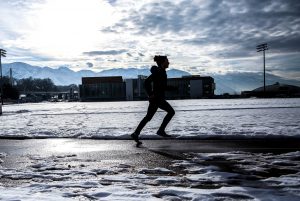The University of Utah is the flagship university for the state of Utah and is located in the heart of Salt Lake City, a city known for its professional sports teams, ski resorts, national parks and poor air quality.
In the years 2012 to 2014, a 2017 Salt Lake Tribune article reveals that Salt Lake City, Provo and Orem were ranked by the American Lung Association as having the sixth worst air quality in the nation. Utah’s poor air quality is due to many factors, but the most prominent is because of the location and layout of Salt Lake City. Salt Lake is located at the base of the Wasatch mountain range in a valley. This layout makes it easy for polluted air to get caught over the city.
The result of bad air is poor visibility and, if the air is thick enough, it can cause respiratory issues for people who are active outdoors. For most of the year, the mountain air in Utah is clear and easy to breathe. However, when the weather turns cold for about four months, problems arise.
On the Utah campus, there are 18 teams that compete in the Pac-12 conference. The athletes train and perform at the highest levels, but it can be hard when the elements get in the way of their success.
The poor air quality in Salt Lake can be attributed to a temperature inversion, which is caused when “a layer of warmer air aloft traps air near the ground and prevents mixing,” according to health.utah.gov.
Inversion typically occurs during the cold winter months, when there is snow on the ground, but poor air is still something that people experience year-round in the state and specifically in the Salt Lake area. Inversion affects everyone in different ways. Some people are more sensitive to it than others, and it is important for individuals to know how they react to different levels of inversion.
The facilities provided to students athletes at the U are state-of-the-art, but there are times when those outdoor fields must be abandoned when the health of an athlete is in question during practice. Luckily, the campus is built for weather, and there are a number of indoor facilities that are available to house teams for practices.

This building is able to be adjusted to warm or cool temperatures in order to prepare teams to play in any weather conditions. This is one alternative for teams to avoid the poor air quality in Salt Lake.
In addition to finding indoor places to practice, some teams will travel for practice. The cross country and track teams will sometimes travel to Park City where the air is not affected by practices.
“If there is a facility with excellent ventilation, that is an acceptable alternative to practicing outside during severe pollution,” graduated athletic training student Ben Cassidy said. “If possible, escaping the pollution by practicing in Park City would be optimal but often not realistic. Thankfully most sports occur indoors during the inversion season.”
The athletic training staff on campus is constantly watching the air quality around the campus so that athletes can practice in a safe environment. Athletic training students are also taught how to watch air quality and help teams to practice safely if needed.
Being an athletic training student on campus means that participants in the program need to be educated on all parts of competing in Utah. This means that students know how to help athletes adjust to the altitude, train in extreme weather and be aware of dangerous air quality levels.
Before each practice, the head athletic trainer will use a special device to monitor air quality on a scale. The scale, which is called the Air Quality Index scale, is a metric which is put out by the government to help people all over the country monitor the air in their area.
If the air quality is read as unhealthy on the scale, coaches are advised of this, and they can take precautions as they see fit in order to run a successful practice. Often, the air pollution fluctuates, and it may not be at its peak all day. This allows coaches to alter practice times according to the air on a given day at a given time.
Although it does not normally reach this level, if the air quality reaches very unhealthy or hazardous, it will affect practices and games immediately. This level of poor air quality is typically seen when fires are spreading nearby and when the ash in the air is making it hard for everyone to function.
“If the air quality is bad enough, we move to an indoor field or we cancel practice,” athletic training student Tom Yamashita. “We also pay attention to athletes with asthma, especially when air is bad.”
In order for a practice to be canceled or altered, the air quality index needs to be above 100. If this number if over 100, it is considered unhealthy for sensitive groups, and both coaches and players will be told to take precautions if they have a history of being affected by asthma.
In addition to the Air Quality Index scale, there is also an air quality guide put out by the NCAA that is specifically for athletes to use. This guide is updated yearly, and it provides three reasons that healthy athletes might be at risk due to air quality. The recommendations made on this website are based on data and statistics taken from the AQI and other government research.
“There are three reasons why otherwise healthy athletes are at special risk for inhaling pollutants. First, as physical activity increases minute ventilation, the number of pollutants that are inhaled relative to when the athlete is at rest are increased. Second, during activity, a larger proportion of air is inhaled through the mouth, which bypasses the body’s built-in nasal filtration system. Third, pollutants are inhaled more deeply and may diffuse into the bloodstream more quickly during physical activity. These risks are heightened in athletes with pre-existing pulmonary or cardiac conditions,” according to the NCAA website.
While healthy athletes may be affected by poor air quality, there are plenty of athletes who have preexisting conditions who may be hindered further by bad air quality. Student-athletes who suffer from asthma are at an even higher risk than other healthy athletes.
In addition to their condition, athletes who suffer from asthma have to deal with both the altitude and less than ideal air quality when they are outside. Because of the risks associated with both poor air quality and elevation in the city, it is crucial that all athletes report any history of asthma or breathing problems to the athletic training staff so that they can be properly educated and helped if something is to go wrong while they are in practice or a game.

Working out with prolonged exposure to the poor air quality can be unhealthy, but in small doses, it is okay. The athletic training staff is present at practices to advise coaches if the air quality reaches dangerous levels, and they are also on hand to help athletes who might be suffering from its effects.
In addition to air quality, it is important for the teams to take into account the thin air of Utah’s elevation. The campus sits at about 4,300 feet, and many athletes come from states like California or Florida where the elevation in some places is less than 100 feet.
Adjusting to competition in higher elevation can be a challenge for athletes, and it is important that they are careful when beginning their training. Working out at high altitudes can cause sickness and exhaustion if individuals are not prepared for it.
There are many areas in which athletes are educated when they are starting their time as a Ute athlete. Two of the most critical are elevation and air pollution. However, with the resources available to student athletes on campus, athletes are able to train in a safe and healthy environment every day.













